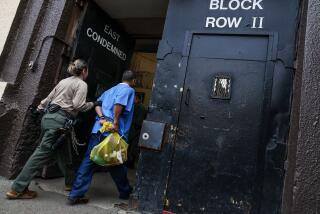California high court won’t stop transfer of inmates to ICE during coronavirus crisis
- Share via
The California Supreme Court on Wednesday refused to order the state to stop transferring immigrant inmates to federal immigration centers during the coronavirus pandemic.
In a 6-1 vote, the state’s highest court said attorneys for the inmates could still file lawsuits in county courts to stop the transfers and could later return to the Supreme Court “raising similar claims if circumstances warrant.” The order did not specify which circumstances might warrant a second review, citing only “the dynamic nature of the pandemic.” Trial judges, the court said, should act expeditiously on such suits.
Two groups of lawyers sued Gov. Gavin Newsom and Atty. Gen. Xavier Becerra on April 24 for allowing state prisons and county jails to transfer immigrants to five crowded immigration detention centers in California.
The associations of criminal defense and immigration lawyers called the Immigration and Customs Enforcement centers “virulent incubators of the virus” with no ability to keep people six feet apart or provide inmates with protective gear such as masks and gloves.
On May 6, a detainee at the Otay Mesa Detention Center in San Diego became the first in immigration custody nationwide to die of COVID-19.
State officials told the Supreme Court that the duty to address any legal violations should be borne by federal officials in charge of the centers.
In deciding the case without a full-blown legal opinion, the court said the lawsuit failed to establish that the governor and the attorney general had a “clear and mandatory duty” to halt the transfers.
In a dissent, Justice Goodwin Liu said the court should have retained authority over the litigation and sought more written legal arguments and fact-finding before deciding whether to order a moratorium on the ICE transfers.
“We are in a state of emergency,” Liu wrote. “We should, without delay, give all sides a full hearing and provide a reasoned opinion answering the questions presented.”
California-based foundations for the ACLU represented the California Attorneys for Criminal Justice and the Southern California chapter of the American Immigration Lawyers Assn. in the case.
They argued that the transfers from California’s jails and prisons accounted for most of ICE’s bookings at the centers. Some inmates sent to detention centers had been released early from criminal custody as part of California’s effort to reduce crowding during the pandemic, the suit said.
California is a sanctuary state that generally prohibits city and county law enforcement from transferring inmates to ICE without a warrant or notifying ICE of release dates.
But county jails can transfer immigrants to ICE after they are eligible for release, and prison inmates may be transferred five days before their scheduled release dates.
There are 4,000 immigrants in California’s five ICE centers.
Liu’s dissent was more than twice as long as the majority’s three-page decision.
“I fear that today’s order will unnecessarily delay resolution of the issues with potentially dire consequences for inmates, correctional staff, the health care system and our state as a whole,” he wrote.
More to Read
Sign up for Essential California
The most important California stories and recommendations in your inbox every morning.
You may occasionally receive promotional content from the Los Angeles Times.











